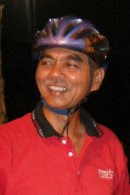CYCLING TO HEALTH
Cycle your way to health
Cycling is a good all-round exercise improving both endurance and aerobic capacity. Cycling tones various muscle groups like the calves and thighs, and strengthens the back. An hour of cycling can burn anything between 250 and 700 calories (1046 and 2930 kilojoules) depending on the intensity. It is also an excellent stress reducer. For those who may be overweight and/or have joint problems which make it difficult for them to do weight-bearing exercise, cycling is a good fitness option.
Possible medical benefits of cycling
Regular cycling at a healthy level has a beneficial effect on many of the body’s organs and systems.
The heart and circulatory system
The heart beats faster to pump blood around the body more quickly to supply enough oxygen to the muscles to allow them to do work. At rest the heart normally pumps about 4 litres of blood per minute, but during moderate aerobic activities such as cycling, approximately 20 litres of blood per minute circulate throughout the body. The heart itself is a muscle and when exercised as in cycling it gets bigger and stronger just as your biceps do.
People who take part in regular physical activity have a lowered risk of cardiovascular disease compared with those who don’t.
Blood pressure
Regular aerobic activity such as cycling can prevent or delay the development of high blood pressure and in people who already have high blood pressure it can reduce blood pressure.
Cholesterol
Regular aerobic exercise improves levels of ‘good’ cholesterol (HDL cholesterol) in your blood.
Brain
People who take part in regular exercise tend to have lower body fat and better lipid profiles than others and hence have less arterial disease which is a risk factor for stroke.
Muscles and joints
Exercise improves muscle strength, coordination and balance, which lessens the likelihood of falls in the elderly and improves joint mobility and lubrication. Muscle endurance and tone will result, and prominence of the working muscle groups like the calves and thighs can be noticed. Posture and balance also improves. Gentle cycling may help arthritis sufferers, lessening joint pain and swelling and increasing flexibility.
Skin
One of the skin’s major functions is as an excretory organ of the body and during cycling, blood flow to the skin increases to rid the body of heat. This improves the elimination of wastes through sweating.
Lungs
An increase in blood carbon dioxide levels causes breathing to become faster and deeper. This action supplies the oxygen needed by the body. There is also evidence that moderate intensity activities such as biking may reduce the risk of lung cancer. Regular aerobic exercise like cycling also increases your lung capacity.
Gallbladder
Researchers have also reported that biking and other routine physical activities of 30 minutes a day may help women avoid gallstone surgery. People who exercise have more active intestines which, along with the improvement in cholesterol profile which occurs in regular exercisers, may help reduce the risk of gallstones.
Erectile dysfunction and cycling
Moderate exercise done on a regular basis generally improves functions of the body, however, after cycling some men have reported penile impairment and short-term impotence resulting from reduced blood supply and nerve compression in the area of the perineum. (In men, the perineum is the area between the scrotum and the anus.)
Analysis of results from a large (1700 men) study called the Massachusetts Male Aging Study has shown that cycling fewer than 3 hours a week was not associated with erectile dysfunction, but cycling more than 3 hours a week may be associated with erectile dysfunction.
Men should take care to ride a properly fitted bicycle and make sure they have a comfortable saddle. Try to position the seat so that it minimises pressure on the perineum. Pointing the bike seat downward a little, or buying a wider seat with better support for the pelvic bones, may help prevent this problem. Narrow seats are said to put the most pressure on the perineum.
A 2004 study of 463 cyclists completing a 320 km-plus cycling event showed that features associated with an increased risk of erectile dysfunction were:
• riding a mountain bike rather than a road bike;
• having the handlebars higher or parallel to the saddle compared with lower than the saddle;
and
• in those who suffered perineal numbness, having a saddle cutout.
If cycling causes numbness or tingling in your penis, take a break and adjust your riding position.
myDr, 2000. Adapted from original material sourced from MediMedia.
________________________________________
myDr Health Information
Perak International Triathlon 23 Jun 2019
-
Alhamdulillah berjaya menamatkan acara ini dengan cukup seksa semasa mod
larian. Langsung tidak mampu berlari hanya berjalan terhenjut-henjut selama
lebih ...
6 years ago










































1 comment:
Thanks for this informative article.No wonder I feel better and lighter now;-)
Post a Comment